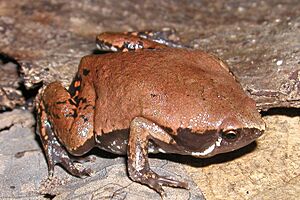Northern sheep frog facts for kids
Quick facts for kids Northern sheep frog |
|
|---|---|
 |
|
| Conservation status | |
| Scientific classification |

The northern sheep frog (Hypopachus variolosus) is a small frog found in Central America, Mexico, and a tiny part of Texas, United States. It lives in warm, dry areas like savannas and open woodlands. This frog is special because it spends most of its time underground. It only comes out at night after heavy rains. The northern sheep frog gets its name from its unique call. It sounds a lot like a sheep's bleat! These frogs mainly eat termites and ants.
Contents
What Does It Look Like?
The northern sheep frog is a small, plump frog. It has short legs and usually grows to be about 2.5 to 3.8 centimeters long. Female frogs are often a bit bigger than males.
Their skin color can be tan, reddish-tan, or different shades of brown. They often have irregular black spots or flecks. Some frogs might have a bright orange, red, or yellowish stripe down their back. This stripe goes from their nose all the way to their rear end. However, some frogs might not have this stripe at all.
Where Do They Live?
Northern sheep frogs live in parts of Central America and Mexico. They are usually found in lower areas near the coast, below 1600 meters (about 5250 feet). Their northernmost home is in southern Texas, US.
On the Pacific coast, they live from northwest Costa Rica up through western Mexico. This includes areas like Sinaloa and parts of Sonora. In Honduras and Guatemala, they also live across to the Atlantic (Caribbean Sea) coast. From there, they range north into Belize and all over the Yucatán Peninsula. They continue up the coast to Nuevo León and Tamaulipas, Mexico. They also live in nearby parts of southern Texas.
These frogs like many different places to live. They are often found in dry areas with thorny bushes and grasslands. They also live in drier open woodlands. Sometimes, they are found in more humid canyons and foothills. They can even live in disturbed areas like pastures and empty lots.
Northern sheep frogs are very good at hiding. They often live in hollow tree roots, animal burrows, or pack rat nests. They can dig backwards into loose soil using their back feet. They might dig just below the surface when it's wet. During dry times, they can dig up to a meter deep!
Why Are They Called Sheep Frogs?
The name Hypopachus comes from two old Greek words. Hypo means "under" or "beneath." Pachos means "thickness" or "fat." This might refer to how stout or thick the frog looks.
The second part of their scientific name, variolosus, comes from a Latin word. Vario means "to make varied" or "variegated." This refers to the markings and spots often seen on the frog's belly.
The most common name for this frog is the "sheep frog." This name comes from its unique call. When the male frog calls, it sounds very much like a sheep's bleat. This bleating sound lasts about two to three seconds.
What Do They Eat?
Northern sheep frogs are very picky eaters. They mostly eat termites and ants. Sometimes, they might also eat tiny flies or other small insects.
How Do They Reproduce?
Sheep frogs lay their eggs between March and September or October. They usually come out to mate after heavy rains. Sometimes, they also come out when fields are irrigated.
Male frogs often call while floating on the surface of shallow pools of water. The female lays her eggs in the water. The eggs float on the surface in loose groups. They usually lay eggs in temporary pools of rainwater. They can also lay them in ponds, marshes, or ditches. A group of about 700 eggs has been seen! These eggs hatch very quickly, usually within 12 to 24 hours.
The tadpoles are brownish with faint marks on their bellies. Some tadpoles also have a stripe down their back. They grow to be about 2.7 to 3.5 centimeters long. After about one month, the tadpoles change into tiny froglets. These young frogs are about 1 to 1.6 centimeters long.
Conservation Status
Even though the northern sheep frog is found in many places and is common in some areas, it is not common in the United States. In the state of Texas, it is protected by law. It is listed as a threatened species there.
The main problems for sheep frogs in Texas are habitat loss and fragmentation. This means their homes are being broken up or disappearing. This happens because of farming and cities growing larger.
Images for kids



